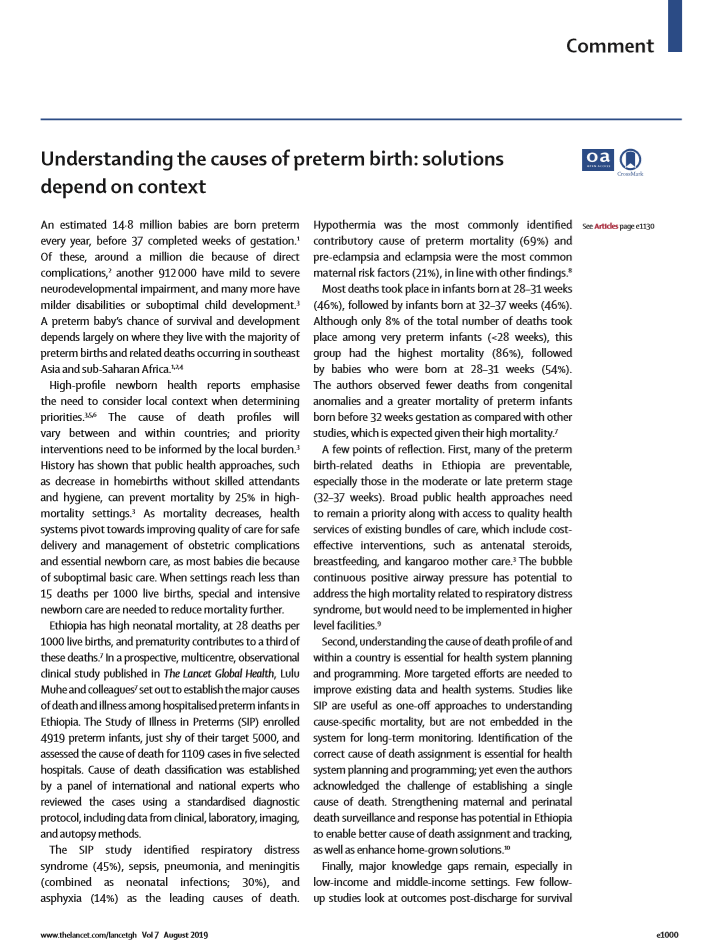This blog was originally published as a commentary in The Lancet Global Health here.
An estimated 14.8 million babies are born preterm every year, before 37 completed weeks of gestation.1 Of these, around a million die because of direct complications,2 another 912 000 have mild to severe neurodevelopmental impairment, and many more have milder disabilities or suboptimal child development.3 A preterm baby’s chance of survival and development depends largely on where they live with the majority of preterm births and related deaths occurring in southeast Asia and sub-Saharan Africa.1, 2, 4
High-profile newborn health reports emphasise the need to consider local context when determining priorities.3, 5, 6The cause of death profiles will vary between and within countries; and priority interventions need to be informed by the local burden.3 History has shown that public health approaches, such as decrease in homebirths without skilled attendants and hygiene, can prevent mortality by 25% in high- mortality settings.3 As mortality decreases, health systems pivot towards improving quality of care for safe delivery and management of obstetric complications and essential newborn care, as most babies die because of suboptimal basic care. When settings reach less than 15 deaths per 1000 live births, special and intensive newborn care are needed to reduce mortality further.
Ethiopia has high neonatal mortality, at 28 deaths per 1000 live births, and prematurity contributes to a third of these deaths.7 In a prospective, multicentre, observational clinical study published in The Lancet Global Health, Lulu Muhe and colleagues7 set out to establish the major causes of death and illness among hospitalised preterm infants in Ethiopia. The Study of Illness in Preterms (SIP) enrolled 4919 preterm infants, just shy of their target 5000, and assessed the cause of death for 1109 cases in five selected hospitals. Cause of death classification was established by a panel of international and national experts who reviewed the cases using a standardised diagnostic protocol, including data from clinical, laboratory, imaging, and autopsy methods.
The SIP study identified respiratory distress syndrome (45%), sepsis, pneumonia, and meningitis (combined as neonatal infections; 30%), and asphyxia (14%) as the leading causes of death. Hypothermia was the most commonly identified contributory cause of preterm mortality (69%) and pre-eclampsia and eclampsia were the most common maternal risk factors (21%), in line with other findings.8
Most deaths took place in infants born at 28–31 weeks (46%), followed by infants born at 32–37 weeks (46%). Although only 8% of the total number of deaths took place among very preterm infants (<28 weeks), this group had the highest mortality (86%), followed by babies who were born at 28–31 weeks (54%). The authors observed fewer deaths from congenital anomalies and a greater mortality of preterm infants born before 32 weeks gestation as compared with other studies, which is expected given their high mortality.7
A few points of reflection. First, many of the preterm birth-related deaths in Ethiopia are preventable, especially those in the moderate or late preterm stage (32–37 weeks). Broad public health approaches need to remain a priority along with access to quality health services of existing bundles of care, which include cost-effective interventions, such as antenatal steroids, breastfeeding, and kangaroo mother care.3 The bubble continuous positive airway pressure has potential to address the high mortality related to respiratory distress syndrome, but would need to be implemented in higher level facilities.9
Second, understanding the cause of death profile of and within a country is essential for health system planning and programming. More targeted efforts are needed to improve existing data and health systems. Studies like SIP are useful as one-off approaches to understanding cause-specific mortality, but are not embedded in the system for long-term monitoring. Identification of the correct cause of death assignment is essential for health system planning and programming; yet even the authors acknowledged the challenge of establishing a single cause of death. Strengthening maternal and perinatal death surveillance and response has potential in Ethiopia to enable better cause of death assignment and tracking, as well as enhance home-grown solutions.10
Finally, major knowledge gaps remain, especially in low-income and middle-income settings. Few follow-up studies look at outcomes post-discharge for survival and development long-term.3 Despite advances in the research agenda for prevention of preterm birth, there is still limited scope for preventing preterm births, especially in lower mortality settings.11 Most evidence on care for preterm babies comes from high-income settings; therefore context-specific research is needed to learn from successes and adopt best fit models in low-income and middle-income settings.3
Preterm birth complications have been, and will likely continue to be, the leading cause of mortality and morbidity in children aged younger than 5 years as a direct or indirect condition.2 Universal coverage of high-impact interventions for newborn health packaged as bundles of care, including special and intensive newborn care, could result in an estimated 86% fewer deaths due to direct preterm birth complications.3 Understanding major causes of preterm mortality is an important step in establishing which of these interventions to prioritise. We commend the SIP study for taking this initial step in Ethiopia.
We declare no competing interests.
